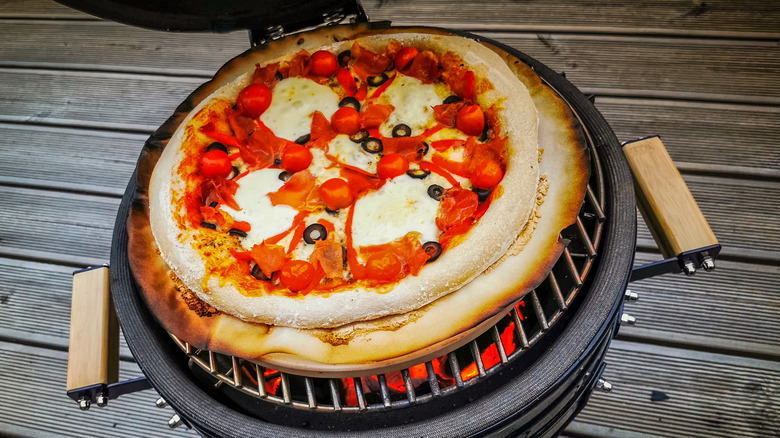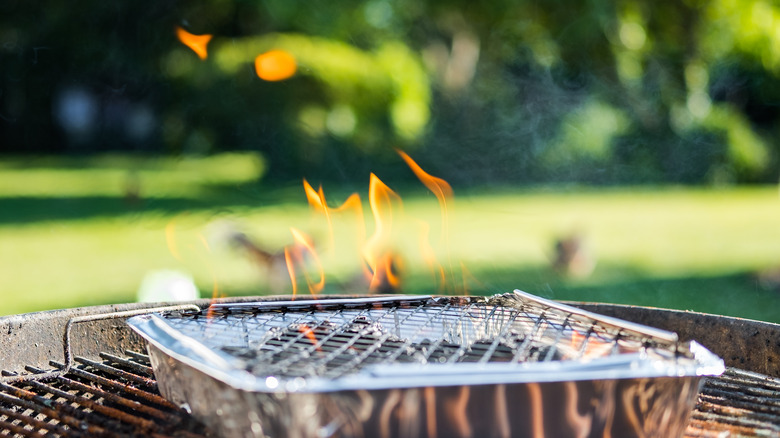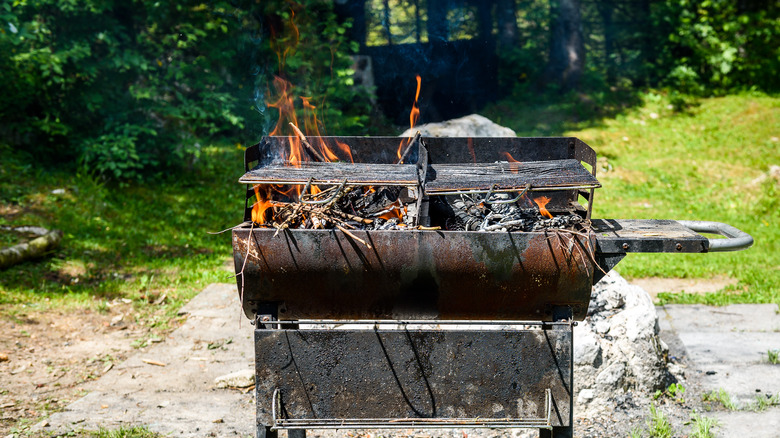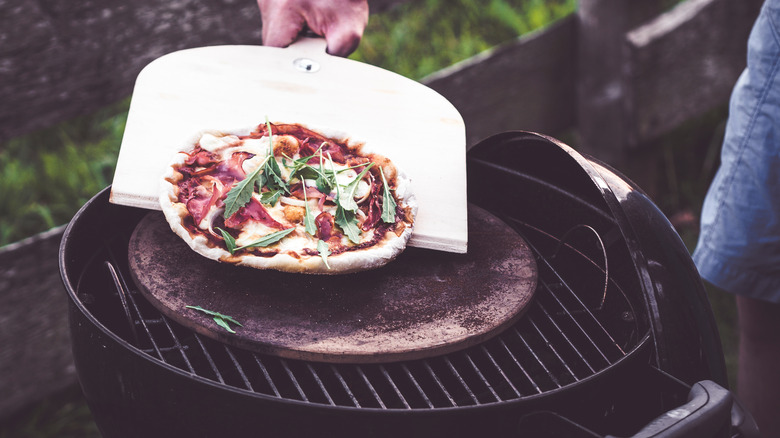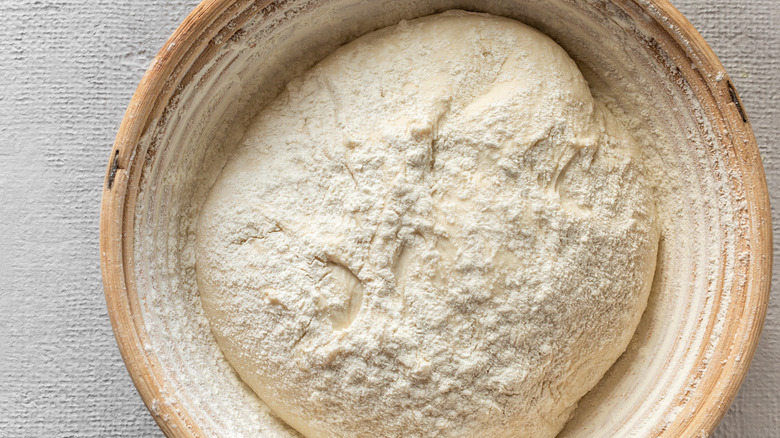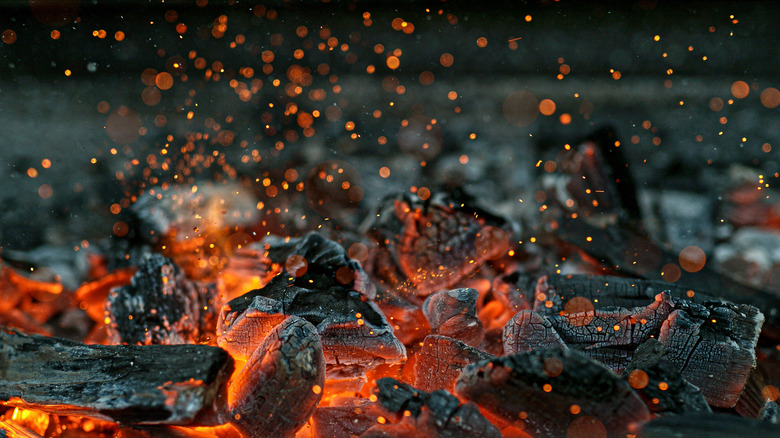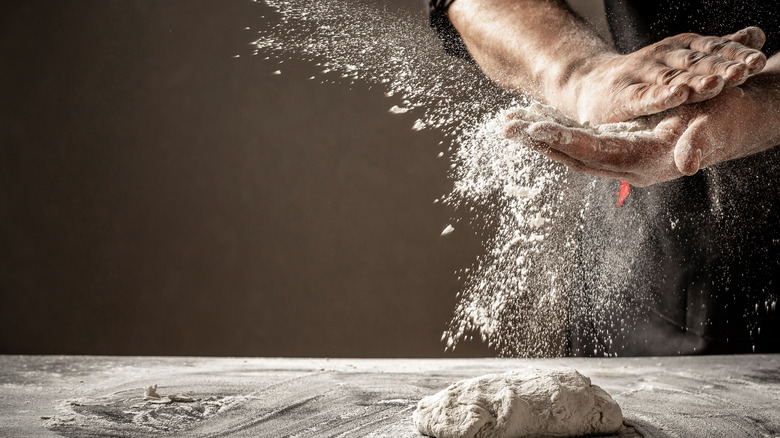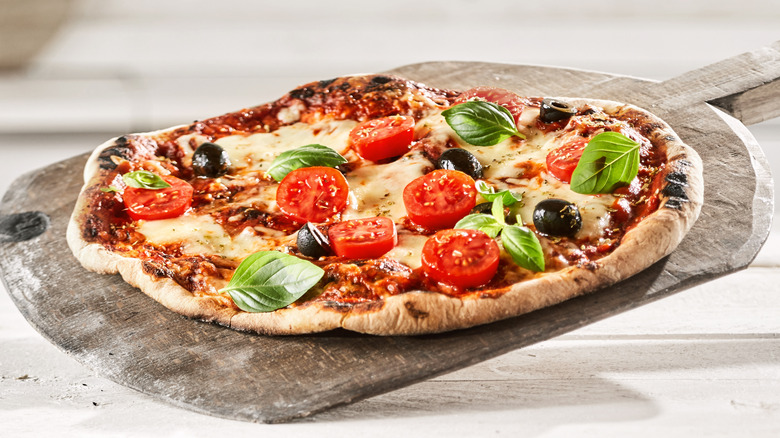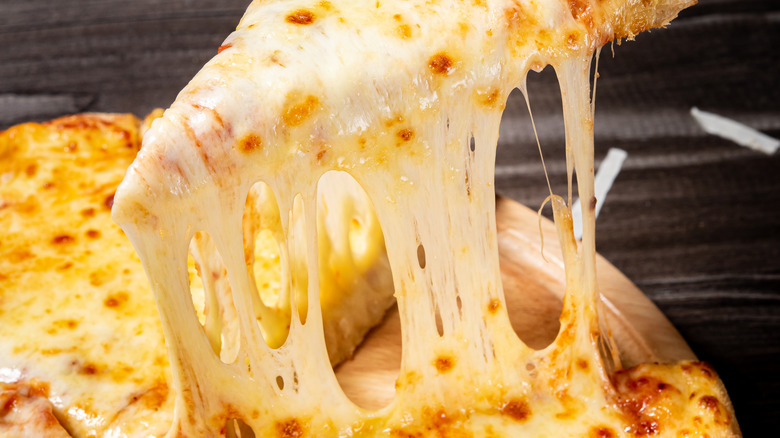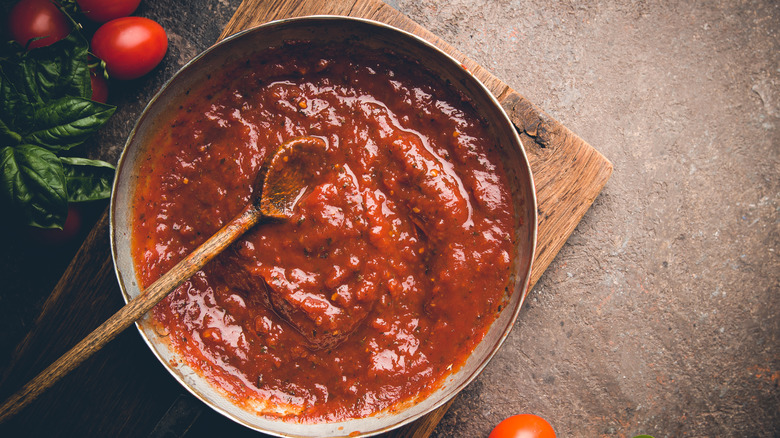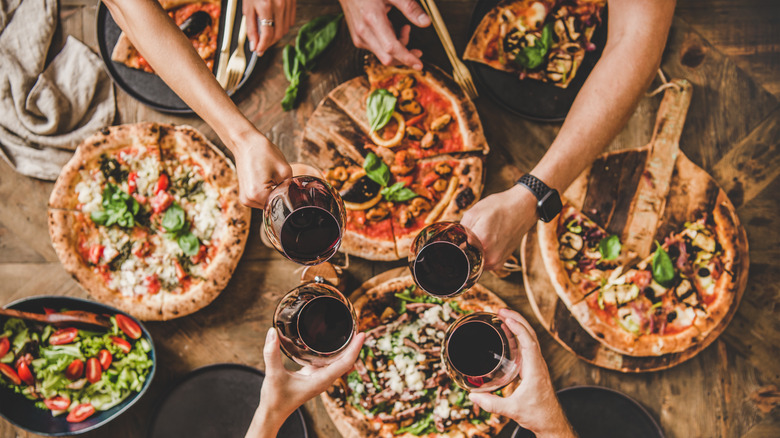Mistakes People Make When Grilling Pizza
Pizza is one of the world's most perfect foods. It's easy to eat while you move, making it a great food on the go, but also a fun meal to share at a table with friends and family.
This is a dish that can be enjoyed in many forms — from simple and rustic to fancy brick oven — but perhaps one of the least appreciated ways to enjoy a hot and sizzling pie of pizza is fresh off the grill.
The heat from a grill is going to create a beautiful charred crust and hot, melty cheese — exactly what we hope for in a pizza — but with the added benefit of the flavors added by the charcoal and the smoke. That's going to lead to a fabulous crust and a great-tasting pizza, whether you are a sauce and cheese traditionalist or going bold with fun and unique toppings.
That being said, pizza-making remains an art and a science, and there are some places you need to be careful not to go wrong along the way!
You didn't prep the grill
A big mistake people make is that they don't prep the grill properly before making pizza. "You want to make sure that the grill is nicely brushed with olive oil," chef Anthony Russo, CEO and founder of Russo's New York Pizzeria & Italian Kitchen tells Mashed.
"If you don't brush the grill with olive oil, then the dough is going to stick to the grill and rip apart when you move it," says Russo. You want your pizza dough to stay intact and in shape instead of tearing.
First of all, make sure you prepare the grill by brushing olive oil before you put on your pizza dough. Then, according to Russo, "Flip the pizza dough when the first side is half-cooked and grill it on the other side."
After you've grilled it for a few minutes, Russo enjoys topping the pizza with tomato sauce, burrata cheese, and arugula. "If you are looking for a more of a crispier pizza crust, then use an olive oil or pesto-based sauce instead of a tomato sauce," says Russo.
You didn't preheat the grill
Pizza cooks best when the pie comes in sudden contact with a hot surface, even when that surface is the grates on your outside grill.
"Dough needs heat to puff up and come out airy, which is why your pizza will be dry and dense unless you preheat the grill," Jim Stonos, a food blogger at Home Cook World tells Mashed.
It's all about getting a good hot surface. "Gas grill owners should preheat their grills with the lid closed and all burners set to high for about 15 minutes," says Stonos, adding that people who are using charcoal grills should give the briquettes up to a half hour to get up to heat.
"Remember to turn down the heat to medium-high and turn off half of the burners on your gas grill, or move the briquettes over to one side on your charcoal grill, allowing you to cook the pie over indirect heat," says Stonos.
The temperature isn't high enough
To get a really great crust and browning bubbling cheese, you are going to need to have a pretty hot grill. Without that, pizza can go wrong, and fast.
Your pizza stone or pan and the temperature in your oven or barbecue grill needs to be hot enough.
"One of my favorite pizzas was made in an at-home bbq grill. It was hot and so was the pizza stone, and that's really important!" HUNGRY's chef Anthony Spino tells Mashed.
Make sure your grill's temperature is at the right level every time so you get a great pizza at the end. However, you don't want it to be too hot and burn the pizza. A good rule of thumb, according to Weber Grills, is if you're grilling indirectly, your grill temperature should reach 375 to 400 F, and if you're grilling on a pizza stone, the grill temperature should reach 450 to 475 F.
You didn't pre-cook the dough
If you wonder why your grilled pizza comes out soggy, then you are probably not pre-cooking your dough. "Grills simply do not have the mass of a proper oven. Their design is also subpar for this task, since whenever you open the lid, most of the heat will escape," Richard Peter, founder of steakbuff.com tells Mashed.
"An oven's domed shape will reflect most of the heat back, so the pizza cooks from the top as well as from the bottom, and the stone on the bottom will draw out any excess moisture as well," says Peter.
An average grill won't cook a pizza from all sides like an oven would. "If you add all ingredients in one go, then you'll end up with a soggy pizza at best, and a burnt mess at worst, because there simply is too much water for it to cook evenly," Peter tells Mashed.
What to do instead? Pre-cook your pizza dough. "Make a nice, round shape from your dough, and add the pizza sauce. Then, once your grill is rip-roaring hot, put the dough on a preheated pizza stone. Cover with a lid, and let it cook for two to three minutes depending on thickness. You don't want to cook it all the way, only halfway through," notes Peter.
This pre-cooked base is perfect for most toppings, and will result in a crunchy, yet fluffy pizza.
You didn't arrange the coal properly
If you have a charcoal grill, then you also need to be aware of how heat is transferred to your food. "If you spread coal evenly on the bottom of the grill, then your pizza will get burnt in the middle, especially if your grill is round and you are cooking directly on the griddle," Richard Peter, founder of steakbuff.com tells Mashed. Why? "Because the round shape reflects heat back to the center of the grill, and that extra heat burns your dough," says Peter.
What to do instead? Well, you have two options. The first option would be to arrange your coal in a circular shape along the side of the grill. "This way, you won't have to use a pizza stone. Just make sure to oil your dough to avoid sticking," says Peter. Or, for the second option, you can use a pizza stone or a cast iron pan. "A pizza stone is superior, because the porous material will draw out excess moisture," Peter tells Mashed.
You messed up the dough
A bad dough is a great (or, rather, really bad!) way to ruin the pizza before the toppings even get added to it. Making the dough is a science, and everything matters. That includes the ingredients and the kitchen being the right temperature to let your dough rise. Making a pizza is baking and cooking combined.
"Make sure to let your dough rise enough," HUNGRY's chef Anthony Spino tells Mashed. "My great grandmother made a Sicilian pizza, which was almost more like a loaf of bread. Its dough was so thick, but still had a crunchy crust. She would let her dough rise twice," says Spino.
It just depends on what you like. And it's also important to make sure that dough is the right thickness. John DeLucie, Executive Chef for Ainslie and Carroll Place tells Mashed that a common mistake people tend to make is, "Either having the dough too thin or too thick. Too much oil causes flare-ups, and not enough oil causes the dough to stick to the grill. You need to find a happy medium with the grill as well, since the dough won't caramelize if it's not hot enough, but it'll get charred if it's too hot."
You put the toppings on too early
Topping your pizza before you've put it on the grill can lead to pizza failure. Unlike a wood-fired oven (or a home oven with a pizza setting), the air circulating on top of your pie isn't hot enough to cook it nice and evenly, which means the right timing is imperative that everything gets cooked thoroughly — but not burnt!
The best way to handle this is, you need to top the pizza after you've cooked it on one side. Otherwise, "You risk ending up with a wet and doughy pie," Jim Stonos, a food blogger over at Home Cook World tells Mashed.
One solution is to grill one side before adding the toppings. "Grill the pizza for two to three minutes on one side, with the lid closed. Then, take it off the heat using your grill tongues and add the toppings to it grilled-side up," says Stonos.
Once done, Stonos notes to put the pizza back on the grill, closing the lid and grilling the pie over indirect heat for six to seven minutes, until the cheese is melted and the bottom is browned.
You put too much cheese on your pizza
We totally get it — you love cheese. Everyone loves cheese. And there are few sexier sights than that delicious cheese pull when a dish is smothered with, well, lots of cheese. But, traditionally, pizzas actually do not have a mountain of cheese.
When you visit Italy, you realize that putting a pound of cheese on a pizza is not necessary. "One of my favorite pizzas in New York only puts a few spoonfuls of macadamia ricotta!" HUNGRY's chef Anthony Spino tells Mashed.
So, make your pizza cheesy, of course, if that's what you enjoy — but not too cheesy. Mozzarella cheese, which is a common choice for pizza, is chock-full of moisture, according to Taste of Home, so if you include a lot of mozz, you may very well end up with a soggy pie. Adding too much cheese can also leave the pizza super greasy, and that's not the goal here!
You messed up the sauce
The sauce can make or break a pizza, because if you use too much, the pizza can end up soggy and fall apart. But obviously, you don't want to skimp on sauce, either. So, one solution is to put the sauce on after the first layer of cheese.
"A lot of people would put the sauce on first, which would make the dough soggy, but when you're grilling, you want it crisp, crisp, crisp, so the next thing you put on the pizza is the cheese, which you grate," New York City-based Fornino chef and owner Michael Ayoub tells Mashed. "The reason why you grate [the cheese] is because you want to make sure [it] melt[s] evenly," says Ayoub. "After the cheese, you apply the cooked sauce, then you can place dollops for each slice and add Parmesan on top, which would be your classic Margherita."
Once you put everything on the dough, you usually warm everything up on the pizza since the ingredients are cooked prior.
You didn't use quality toppings
A pizza is only as good as its toppings. That goes from the flour on the dough, to the herbs on the topping, and everything in between. The better the toppings, and the more quality ingredients, the better pizza you get as a result.
That's good advice for whatever you're making! Taste is everything.
Pre-cooking vegetables is another way to get quality results from your ingredients. "Not pre-cooking your toppings, especially vegetables with high water content" is a mistake, Leif Evans, culinary arts chef-instructor at the Institute of Culinary Education tells Mashed.
If you don't pre-cook your toppings, you'll likely end up with a soggy pizza. "Pre-cooking vegetables and other toppings can help keep a pizza crisp, because it removes some of the moisture content," says Evans. Additionally, because grilling pizza is a fairly quick process, pre-cooking the toppings also allows for consistent, even cooking.
Another aspect of maintaining quality is to avoid putting too many ingredients on a pizza. "It makes your pizza cook unevenly and maybe burn in some spots," says HUNGRY's chef Anthony Spino. Simple and perfect!
